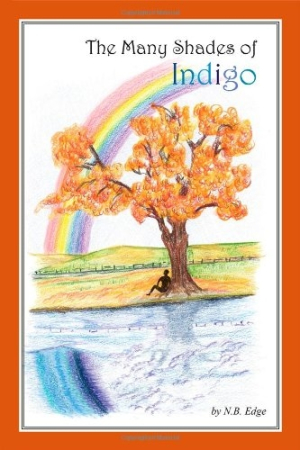The Many Shades of Indigo
The story N.B. Edge tells in The Many Shades of Indigo is not a pretty one. His focus is a vulnerable young man named Indigo and a small group of friends, all of whom are trying their best to make it through high school and out of their underprivileged surroundings. While this at first appears to be a Young Adult novel, the story contains many disturbing situations and is decidedly not for younger readers.
Edge’s teenage characters are quite well developed, and relating to their angst and insecurities is not difficult. The dialogue, particularly the conversations between teens, is right on target, almost like overhearing kids talking at the mall. These characters crave love and acceptance—certainly a universal desire—but what they face in seeking it is far from normal.
Most of the kids in Edge’s novel are let down in the worst imaginable ways by the adults in their lives, the very people who should be helping them along. From alcoholism at home to regular physical abuse, the horrors are insidious, and just when one horrendous thing is unveiled in the narrative, something even worse seems to happen. The teens often deal with their own terrors in silence, choosing secrecy in order to keep the peace and avoid hinting at anything that might impair their acceptance among their peers. What the characters think they must endure is unacceptable, yet they do their best to take it all in stride. Edge presents few adults who could honestly help them, anyway. Even the best parent among them offers too little, far too late.
Sexual abuse by trusted adults is pervasive in Edge’s story, and the incidents described range from bone chilling to absolutely revolting. His tales of rape, forced oral sex, and homosexual encounters contribute to a rather uncomfortable read. When a high school athletic coach coerces a student into a sexual relationship, the teen actually believes that he is helping the man: “I felt so bad… . I knew first hand how he felt. I wanted to save him. I felt I could be the person he needed to help him face his past.” Later, the boy admits to a friend that the coach actually hits him as well: “he hit me one or two times before, but it was because I was disrespecting him … I shouldn’t have done that.” Sadly, this young victim expects nothing better.
Many Shades of Indigo is very well written, but it is an overwhelmingly depressing story with no hope or redemption offered. The text is quite clean, with only a few scattered typos, and Edge interestingly tells individual “stories” to provide individual characters’ points of view. However, reading about their situations is particularly disturbing in that violence and death—murder and suicide—are the only final “solutions” Edge offers for these characters. Any of them who are still alive at the end of the story are undoubtedly irreparably damaged, but Edge does not discuss their fate.
In his epilogue, Edge states, “To me, The Many Shades of Indigo represents all that is wonderful in the world and all that’s beautiful in human beings.” Many readers will strongly disagree. There is nothing of beauty or wonder in abuse, and virtually every one of Edge’s characters is terribly mistreated in one way or another. Add a depressing couple of murders, an attempted suicide, and a successful suicide to the mix, and there is little splendor here.
Reviewed by
Cheryl M. Hibbard
Disclosure: This article is not an endorsement, but a review. The publisher of this book provided free copies of the book and paid a small fee to have their book reviewed by a professional reviewer. Foreword Reviews and Clarion Reviews make no guarantee that the publisher will receive a positive review. Foreword Magazine, Inc. is disclosing this in accordance with the Federal Trade Commission’s 16 CFR, Part 255.

